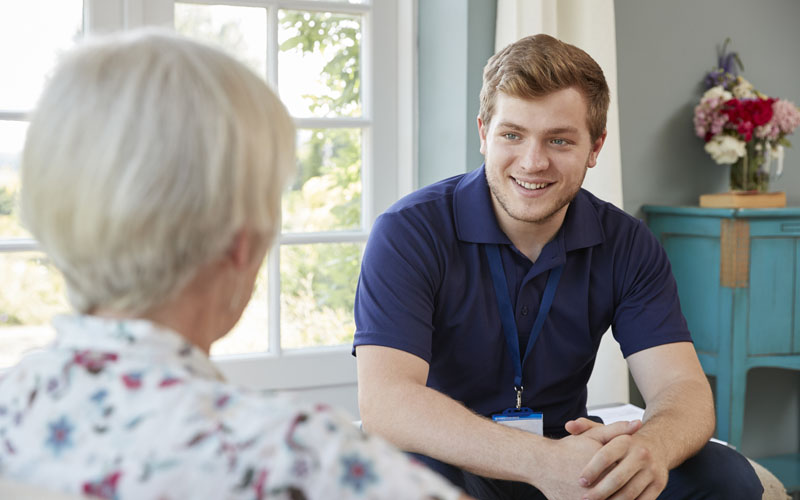Mental health in Germany:
A focus on ward-equivalent treatment
Laura Kirschbacher, Corporate Communications Manager at Pfalzklinikum AdöR talks about
ward-equivalent treatment (WeT), a special kind of hometreatment, where a multi-professional team visits the patients at home. She accompanied WeT social worker Linda Seez to find out more
Ward-equivalent treatment (WeT) is a complex psychiatric psychotherapeutic treatment in the patients’ home envionment in times of acute diseases and is, thus, an alternative to an in patient stay. WeT, “Stationsäquivalente Behandlung (StäB)” in German, is modelled after international home treatment approaches, like Crisis Resolution Team (CRT), Assertive Community Treatment (ACT), Case Management (CM), Community Mental Health Team (CMHT). Ward-equivalent treatment has been possible at Pfalzklinikum since January 2018, after the cost unit and the German Hospital Society agreed on an action framework for home care 1 which should reach patients who, for various reasons, cannot or do not want to be treated in a clinic.
The S3 guideline “psychosocial therapies in case of severe mental diseases” also recommends team-based, multi professional and out-patient treatment in a community. 2 So, WeT closes a gap between the hitherto exclusively in patient complex treatment and out patient healthcare. At Pfalzklinikum Klingenmunster, a multi-professional team is daily on duty for WeT and currently visits five patients within a radius of approximately 10 kilometers.
The basis for the WeT service is an in-patient indication and, therefore, the duration of treatment is limited as it is on a ward. The cooperation with the wards is close. In most cases, employees of the nursing service work partially on a ward, as well as for WeT, thus, knowing both methods of work. In Klingenmunster, WeT is a specialised group under the umbrella of the out patient and outreach services and benefits from the experience gained here in terms of the in and out-patient work. By integrating the new treatment offer into the existing psychiatric-psychosocial healthcare structure, the duration of treatment of mentally ill persons shall be reduced and their life quality will be improved.3
At Pfalzklinikum Klingenmünster, the Head Physician and Vice Medical Director, Dr Sylvia Claus, is in charge of the project together with the senior physician, Dr Esther Klingelhöfer, and Jeannette Berger, Head of the Nursing Department for Out-Patient and Outreach Services.
When the ward comes to the patient
It is Monday morning and Linda Seez is standing in the “control centre” in front of a colourful organisation board: the operational plan for the employees of the ward-equivalent treatment team at Pfalzklinikum Klingenmünster is prepared analogously. There is a good reason for this because every day a team member visits the five WeT patients at home for treatment – professional team, the organisation is a logistic masterpiece solved best with pen and magnets. This weekly schedule sets the structure; spontaneous adjustments and new admissions, however, call for the team members to be flexible.
Today, the tour starts with a female patient in Bad Bergzabern, which is only a stone’s throw away. The woman is glad about the visit and presents to me a picture she works on every day, representing the small steps she is taking in her therapy. Linda Seez spares one hour for her patient: she sorts out the mood and motivation, discusses the structure of the day and calmly prepares the next tasks on the way to independence. “The WeT team’s visits give structure to my day”, the patient declares, and in hospital I would not feel better.”
Exactly what lacked in the landscape of psychiatry
This thought is shared by most WeT patients as Jeannette Berger, Head of the Department of Outreach and Out Patient Services, reports: “Ward-equivalent treatment is exactly what lacked in the landscape of psychiatry. Here, we reach people who do not want to go to a clinic.” Driving from Bad Bergzabern to Godramstein to the next patient, we talk about the particular characteristics of ward-equivalent treatment. The treatment is strongly individualised and through intense daily contact with the patients treated in their familiar environment, other persons living in the same household can be closely involved. That way, difficulties in daily life become obvious and can be dealt with together.
“However, you have to be aware of the fact that you are a guest at the patients home”, Linda Seez underlines. As guests, we are sitting in the cosy dining-room of today’s second patient. Only the clock is ticking as the conversation does not get going immediately. Empathetically Linda Seez directs the conversation towards the patient’s biographical back ground. The respective work exhausts the woman fast, which is why the appointed time is adjusted to the needs and shortened. Indeed, at the beginning of each treatment, a plan is set up together with the patient allot ting the specific professional groups needed, but the WeT team also reacts flexibly to various treatment needs. If necessary, the psychotherapist, for example, visits a patient more often, while the occupational therapist has a closer contact with other patients.
Flexible working and constructive error culture
Spontaneous changes demand much flexibility from the team, Jeannette Berger confirms: “This work is only possible because of a tolerant, creative and innovative team.” She frankly confesses: “We are a learning system, nothing is fixed, many things are questioned and we learn from errors. This is only possible with a highly motivated team and the courage of the chief physician, Dr Claus .”
“WeT belongs to the Clinic for Psychiatry, Psychosomatics and Psychotherapy at the Klingenmünster site. The close interaction of wards and ward equivalent treatment is not only of fundamental importance for its success but also structurally arranged”, as Jeannette Berger explains: “Lilian Fischlhammer and Lisa Schotter, for example, two pioneers of ward-equivalent treatment at the Klingenmünster site, also work partially on the ward. It is essential that they bring along their knowledge from the ward.”
“Ward-equivalent treatment has been possible at Pfalzklinikum since January 2018, after the cost unit and the German Hospital Society agreed on an action framework for home care which should reach patients who, for various reasons, cannot or do not want to be treated in a clinic.”
“You have to like flexibility, you work very autonomously and not every body enjoys going to the patients’ home environment”, Nina Heid, a master student of psychiatric nursery outlines. It is also a question of whether dangerous situations may arise for the visiting WeT team members. Of course, they thought about this, Linda Seez says, but the team is specially trained in deescalation for out-patient work.
For the remaining day, no visits are planned. Documentation that is much more extensive than that of the ward has to be completed, and the next days have to be planned and telephone calls must be made. “Today was an extremely quiet day”, Linda Seez remarks. This is also due to the fact that ward-equivalent treatment with currently five patients is still in its initial stages. Basically the “mobile ward” is scalable – with the appropriate staff and the required IT-infrastructure in the form of a virtual ward more patients can be cared for. At the Pfalzklinikum Klingenmünster site, the first steps are made, and others will follow to successfully establish this future-oriented concept as an integral part of complex psychiatric-psychotherapeutic treatment.
References
1. Fricke, Arno: DGPPN about Home Treatment: “Für den Start kann man damit leben”. In: ÄrzteZeitung, online at: https://www.aerztezeitung.de/praxis_wirtschaft/special-arzt-patient/article/941554/dgppn-home-treatment-start-kann-man-damit-leben.html (accessed on 02/16/2019).
2. Deutsche Gesellschaft für Psychiatrie, Psychotherapie und Nervenheilkunde (ed.): S3-Leitlinie Psychosoziale Therapien bei schweren psychischen Erkrankungen. S3-Praxisleitlinien in Psychiatrie und Psychotherapie. Springer Verlag, Berlin, Heidelberg, 2013. https://www.awmf.org/uploads/tx_szleitlinien/038- 020I_S3_Psychosoziale_Therapien_10-2012.pdf
(accessed on 02/1712019).
3. Deutsche Gesellschaft für Psychiatrie und Psychotherapie, Psychosomatik und Nervenheilkunde e.V. (DGPPN) et al.: Gemeinsames Eckpunktepapier zur Stationsäquivale nten Behandlung (StäB). Online at:
https://www.dgppn.de/_Resources/Persistent/ee7cd301Ofd2de4e9d144856cd436cb0f864d3e8/2018-06-18_Eckpunktepapier_St%C3%A4B_Verb%C3%A4nde_Logos_fin.
pdf (accessed on 02/16/2019).


